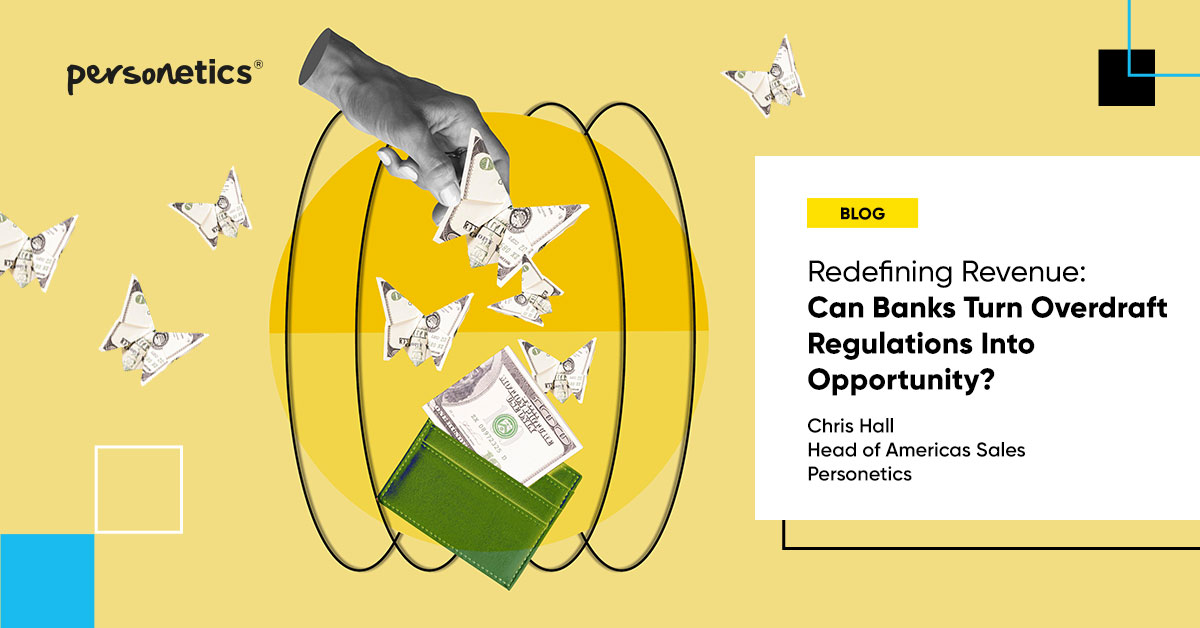February 13, 2024
Redefining Revenue: Can Banks Turn Overdraft Regulations Into Opportunity?

Introduction to the Consumer Financial Protection Bureau (CFPB)
Led by the Consumer Financial Protection Bureau (CFPB), US regulators have spent the past two years pressuring banks and credit unions to reduce fees and rework policies around non-sufficient funds (NSF), overdrafts and overdraft protection (ODP). Most recently, the CFPB took on the regulatory status of overdraft fees with a proposed rule announced on January 17. The sustained regulatory pressure, designed to protect consumers from excessive fees and promote fair banking practices, presents challenges for financial institutions, particularly in revenue generation. But when we consider what’s changed and what hasn’t changed, we find they also open doors to innovative cross-selling and upselling strategies.
Understanding the New Overdraft Fee Regulations
The CFPB’s new proposed rule targets language in Regulations E and Z, especially the longstanding exemption of overdraft services from the provisions of the Truth in Lending Act. The CFPB intends for the rule to apply to banks and credit unions with more than $10 billion in assets, which have historically generated substantial revenue from overdraft fees. In 2019, before first the pandemic and then recent regulatory initiatives drove it down, overdraft fee revenue was estimated at $12.6 billion, demonstrating the significant financial impact of these fees on both banks and consumers that have paid them.

Challenges Posed by New Regulations
The impact of the cumulative regulatory pressure and rulemaking is twofold: a direct financial hit to banks and a need for a strategic shift in customer relationship management. The CFPB estimates that the new rule may save consumers around $3.5 billion annually in fees. These savings translate to a significant reduction in revenue for banks.
Changing the relationship and serving customers better
The regulation of overdraft fees provides an opportunity for financial institutions to reevaluate their relationship with customers. Instead of relying on fees generated by customers overdrawing accounts, banks can focus on adding value through relevant products and services.
To grasp why the word “opportunity” applies here, consider what’s changed and what hasn’t changed: Regulations have been addressing the symptoms but not the cause of cashflow challenges. These regulations address bank overdraft fees, not penalties imposed by payees on late and bounced payments. So, customers will still struggle with managing cash flow and payees will still require payment and assess late fees and penalty fees. Banks must find newer and better ways to help customers avoid spending beyond their projected cash flow.
Banks have an opportunity to take a strategic approach to cross-selling and upselling through enriching, analyzing and providing feedback on customer cashflow. Banks can then offer solutions at, or ahead of, the time of need.
To provide timely solutions, the banks must engage with customers in the digital channel. It’s where customers spend their time. Understanding customer needs and preferences becomes crucial. Banks can use enterprise-class data tools for personalization at scale (like Personetics). Data tools will allow banks to offer personalized services and products to manage cash flow issues.
The changed landscape puts added weight on more expansive relationships. One example: overdraft protection requires a protecting account. Multiple deposit accounts are a win/win. ODP protects customers and multiple accounts create more valuable banking relationships for banks. There are more opportunities for banks to engage their customers, including promoting lines of credit and incentives to save incrementally. Digital banking provides the perfect context for such engagement.
A smart approach leads to more effective cross-selling and upselling by matching customer needs with the bank’s offerings. This approach weaves into a larger personalization-based trust strategy that can help increase overall customer value and reduce attrition. The relationship can expand to include educational initiatives and loyalty programs as well.
The key to this approach is relevance and timeliness. Without a transaction and balance-focused data strategy, the bank will be unable to help customers manage cash flow, cross-sell, or provide better service at critical moments.
Case Studies & Examples – Specific Banks’ Responses to Overdraft Fee Regulations
Several major banks have made significant changes to their overdraft policies in response to regulatory pressures and changing consumer expectations. These changes are part of a broader trend in the banking industry to reduce or eliminate overdraft fees, thereby shifting their revenue models and customer service strategies.
PNC Bank: In April 2021, PNC Bank introduced the ‘Low Cash Mode’ service for its Virtual Wallet customers. This service provides real-time alerts for low balances and a 24-hour grace period to avoid overdraft fees. This innovative approach aims to give customers more control and flexibility.
Ally Bank: In a notable move, Ally Bank eliminated all checking account overdraft fees starting in June 2021. This decision was a part of their effort to support customers and align with consumer-friendly practices.
Capital One: In December 2021, Capital One announced elimination of all overdraft and NSF fees. This was a significant step, considering the substantial revenue these fees generated for the bank. For example, the elimination of these fees was projected to cost Capital One around $150 million annually.
Bank of America: In 2022, Bank of America announced the elimination of NSF fees and a reduction of overdraft fees from $35 to $10. Additionally, Bank of America introduced a small-dollar loan option for checking account customers, allowing them to borrow in increments of up to $500.
Regions Bank and Wells Fargo: Also in 2022, both banks announced the elimination of non-sufficient funds fees and linked-account transfer fees triggered by overdrafts and announced early access to direct deposits. By September 2022, Regions had rolled out small-dollar lines of credit (up to $500) to help customers manage short-term financial needs, with Wells Fargo following that November. Wells Fargo also used 2022 to roll out a 24-hour grace period for overdrafts, with Regions Bank following in 2023.
These examples show a trend among major banks towards more customer-friendly overdraft policies, with many smaller, traditional banks that hadn’t taken such steps now doing so. This shift is driven by (1) regulatory scrutiny and (2) competition from digital-only financial services providers (who typically don’t charge these fees). The changes these banks are making both align their policies with an emerging regulatory consensus and represent a strategic move to retain and attract customers by aligning more closely with their financial needs and preferences.
It’s important to note that the tools required to effectively do this are not limited to just the world’s largest banks. Shifting to cross-sell and upsell strategies can be enabled for both large and small FIs.
Success requires innovation in product offerings. This is not rocket science, but it’s an important part of the overall approach to securing the right cross-sell with bank customers.
Conclusion
The regulation of overdraft fees, while challenging, offers a unique opportunity for financial institutions. Banks have an opportunity to redefine their customer relationships and gain strategic advantage through better sales.
By focusing on value-added services and leveraging tools like Personetics for data-driven insights, banks can turn these regulatory changes into a strategic advantage.
I encourage you to explore this enlightening article by Jody Bhagat, which details how banks can effectively reshape their Overdraft Response to generate significant business impact.
- I want to express my gratitude to Chris Musto for his invaluable assistance and advice in shaping this article
Want to explore how your bank can harness the power of AI to engage and serve customers? Request a demo now
Latest Posts

Why Asia Pacific Pacific Banks Must Lean into Cognitive Banking: A Conversation with Dr. Dennis Khoo

Explore our Spring Release Highlights – From Integrated Marketing Offers, to Custom Trackers, and AI Innovation

Showing the Human Side of Digital Banking: Insights from Desjardins' Nathalie Larue

Chris Hall
Head of Americas Sales
Chris Hall has an undergraduate degree in Computer Science from University of Idaho, a Master’s degree in Finance from Pepperdine University, and has spent more than 30 years helping people use technology better. Mr. Hall is the North American Head of Sales for Personetics, where he’s focused on helping banks deliver better financial outcomes through data driven personalization. Mr. Hall co-authored a marketing book for small businesses entitled “No BS ROI,” has lectured at California Institute of Technology, and is listed on the application for a small number of marketing technology patent applications. When not working with bankers and credit union leaders around the country, he can be found mountain biking or skiing in Boise, Idaho, where he lives with his wife, Kelly, their daughter, and a small quantity of disobedient dogs.









